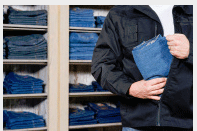 According to the National Association for Shoplifting Prevention (NASP) there is no profile of a typical shoplifter.
According to the National Association for Shoplifting Prevention (NASP) there is no profile of a typical shoplifter.
And while three quarters of the shoplifters are adults, the rest are under age persons. Men and women shoplift equally, and more than three quarters of the shoplifting done in the United States is considered opportunistic. Habitual shoplifters, which according to the NASP steal an average of 1.6 times per week, employee theft and organized shoplifting rings are a major concern for the retail industry, and the cause of billions of dollars of loses.
For more about this and other topics follow the links below.
Habitual Shoplifters are an International Concern
Shoplifting and other forms of retail theft cost retailers tens of billions of dollars each year. As a result retail leadership has learned to recognize the value of a well-trained management staff and a professional loss prevention department. We have learned to drive operational efficiency, and ensure that controls are in place and adhered to throughout the organization. We have learned the value of deterrence, limiting the desires and the opportunities for theft and other losses by integrating loss prevention concepts with retail practices. We have embraced a belief in training and awareness as being at the heart of a successful loss prevention program.
Despite our best efforts, there will always be those that will test our resolve. For those retail loss prevention professionals that must deal with shoplifters every day, we are trained to recognize that a shoplifter can look like anyone—shoplifters are not bound by gender, race, creed, or social standing. Professionals are trained to identify patterns of behavior and must follow strict protocols before shoplifting suspects can even be approached. There are well-defined principles that guide our decisions, and clear steps that must be followed before an apprehension is made.
But there are times when specific individuals will draw our immediate attention. Based on well-established patterns of previous behavior, the habitual thief—those that are known to have stolen from us on multiple occasions in the past—deserve our efforts and focus. While not a definitive indicator of future intentions, their presence in the store warrants priority consideration.
Teton Village Sports shoplifters arrested
Teton County Sheriff’s Office deputies, who were patrolling the area, arrived within seconds and positively identified the suspects as those wanted for the original crime. The deputies say that the suspects were in the process of victimizing the store for the second time.







